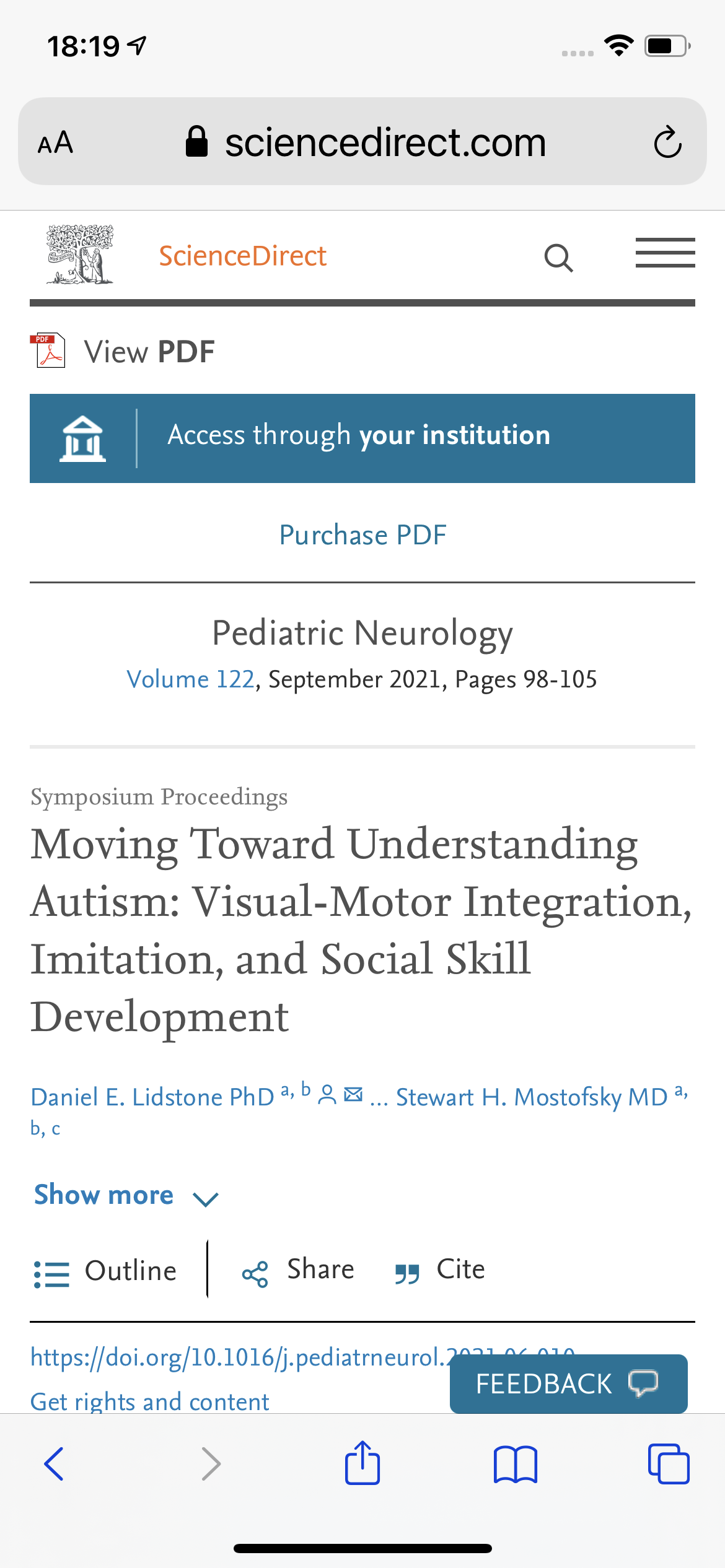
Sensory integration theory and practice is so often criticised for having a poor evidence base. Yet, here we find clear evidence and support for the theory, and indeed practise of Ayres’ Sensory Integration. That the research team included an Occupational Therapist and assessment included those that are core to our clinical practice speaks clearly. This research adds strength and credibility to Occupational Therapy as a profession and those within in our profession who have curiously explored and discovered the links and relationships between sensory differences and challenges of participating in everyday life.
Brainstem white matter microstructure is associated with hyporesponsiveness and overall sensory features in autistic children
https://rdcu.be/da6oa
Background
Elevated or reduced responses to sensory stimuli, known as sensory features, are common in autistic individuals and often impact quality of life. Little is known about the neurobiological basis of sensory features in autistic children. However, the brainstem may offer critical insights as it has been associated with both basic sensory processing and core features of autism.
Methods
Diffusion-weighted imaging (DWI) and parent-report of sensory features were acquired from 133 children (61 autistic children with and 72 non-autistic children, 6–11 years-old). Leveraging novel DWI processing techniques, we investigated the relationship between sensory features and white matter microstructure properties (free-water-elimination-corrected fractional anisotropy [FA] and mean diffusivity [MD]) in precisely delineated brainstem white matter tracts. Follow-up analyses assessed relationships between microstructure and sensory response patterns/modalities and analyzed whole brain white matter using voxel-based analysis
Results
Results revealed distinct relationships between brainstem microstructure and sensory features in autistic children compared to non-autistic children. In autistic children, more prominent sensory features were generally associated with lower MD. Further, in autistic children, sensory hyporesponsiveness and tactile responsivity were strongly associated with white matter microstructure in nearly all brainstem tracts. Follow-up voxel-based analyses confirmed that these relationships were more prominent in the brainstem/cerebellum, with additional sensory-brain findings in the autistic group in the white matter of the primary motor and somatosensory cortices, the occipital lobe, the inferior parietal lobe, and the thalamic projections.
Limitations
All participants communicated via spoken language and acclimated to the sensory environment of an MRI session, which should be considered when assessing the generalizability of this work to the whole of the autism spectrum.
Conclusions
These findings suggest unique brainstem white matter contributions to sensory features in autistic children compared to non-autistic children. The brainstem correlates of sensory features underscore the potential reflex-like nature of behavioral responses to sensory stimuli in autism and have implications for how we conceptualize and address sensory features in autistic populations.
Dr Ayres focussed our attention on the importance of the brainstem and white matter in receiving and integrating sensory input. This article focuses us on the molecular mechanisms that may be creating sensory differences in those who are Autistic.
Research like this will leave our profession with little option but to acknowledge, that like for a great many explorers and innovators, disruption of ideas is not popular and it can take time for others to adopt the new ideas, even with compelling evidence.
It would not be in keeping with our professions humble and quiet ways of working, almost invisibly to enable and empower to exclaim “we told you so”. But, it would be fitting and proper, for recognition of Dr Ayres’ incredible and often much maligned efforts in this field to be recognised, and most especially within our own profession.

The ability of our profession to look in on itself and reflect is something we are asked to do each day in practice; to reflect on and adapt to support the ever changing worlds of our clients, and how we practice within this. Yet, we are seem stuck around this very important and growing area of scientific interest, which is reshaping healthcare practice.
If we do not reflect on, and read the evidence, do not adapt and change the rhetoric about sensory integration, we will undermine or professions reputation as having credible scientists and artful practitioners. We can not continue to ignore the science;
- the senses are core to and underpin learning, development and function
- sensory differences can interfere with participation in everyday life
- addressing underlying sensory challenges, building on and utilising sensory strengths creates opportunities for development of skills and abilities to function and participate.
- that we can and should work with our clients on their sensory goals to support their participation goals; facilitating their journey to living their life to the fullest.
Without the senses, and adequate processing and integration of sensory input within the body and brain, feelings and emotions, language, cognition, development, learning, movement and actions, connection and participation are compromised or impossible.
![ASI Wise & Sensory Project [Ayres Sensory Integration Education across Wales, Ireland, Scotland and England]](https://i0.wp.com/sensoryproject.plume.co.uk/wp-content/uploads/2018/04/cropped-Asi-wise_logo-01-1.jpg?fit=2362%2C2286&ssl=1)





You must be logged in to post a comment.